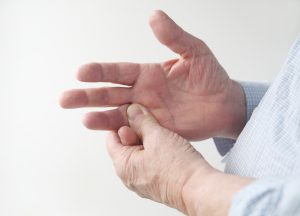Everything you need to know about trigger finger: meaning, cause, symptoms, diagnosis and treatment
One of the most common conditions of the hand is a so-called trigger finger. You suffer from when you are struggling to stretch a finger. After trying for a short while, the finger extends with a shock. There are many different names for this phenomenon. In addition to ‘trigger finger’ it is also referred to as ‘snapping finger’, ‘haunting finger’ or ‘hopping finger’. The Latin name for this disorder is tendo vaginitis stenosis (TVS).
What is a trigger finger?
A trigger finger is an innocent but annoying disorder. In this condition, the bending tendon of one of the fingers is inflamed. This passes through a tendon sheath from the end of the palm to the upper joint of the finger. Due to the inflammation, the flexor tendon is swollen, causing it to slide very difficultly through the sheath. This causes the finger to shake – also called triggering – during stretching. The tendon may end up completely jammed in the sheath. The finger must then be helped to stretch. Sometimes the tendon sheath itself can also be inflamed.
Especially women between the ages of 45 and 65 may suffer from a trigger finger. This complaint is most common in the tendon to the thumb, middle finger or ring finger. It is rare that this condition affects the index finger or pink. Sometimes this condition also occurs in young children. Usually it is a hunch of the thumb. This is called an inborn (congenital) trigger thumb.
What causes a trigger finger?
It is not always clear what the cause is of the inflammation of the flexor tendon. It is believed that overload of the affected finger can usually be the cause. Everyone can basically get a trigger finger. People with diabetes, rheumatism or carpal tunnel syndrome are at greater risk.
What are the symptoms of a trigger finger?
Initially, there is a slight pain during stretching or bending of the finger. The irritation of the flexor tendon increases further as the thickening slides along the tendon sheath increasing the pain. You are getting more trouble bending or stretching the finger and feeling a “shock” while making these movements. Then there is a swelling in the palm of your hand. Eventually the finger can get stuck in a stretched or bent position. Then the finger needs to be helped to restore to the desired position.
Do you have pain in your fingers but do not you fully understand these symptoms? Perhaps you have osteoarthritis in your fingers.
How is a trigger finger diagnosed?
A malfunction of a finger clearly indicates a trigger finger. The doctor can therefore easily make a diagnose based on a personal interview and physical examination. This examination does not hurt. It is not necessary to make X-rays.
How is a trigger finger treated?
The purpose of the treatment is to restrain the inflammation of the flexor tendon. Therefore, the doctor will prescribe anti-inflammatory analgesics. In addition, you can get the advice to wear a (night) splint so that the inflamed tendon does not scrape along the edge of the sheath any more. An injection with corticosteroids is also a possibility. This is injected in combination with an anesthetic at the beginning of the tendon sheath.
When is surgery performed at a trigger finger?
If the treatment does not have sufficient results or the complaints continue to return, the doctor may suggest a mild surgical procedure. This is done at the outpatient clinic under local anesthesia and takes about 10 minutes. The tendon sheath is cut longitudinally (1.5 cm), giving the thickened flexor tendon more space. Generally, you will have little problems after this surgery.

Share this page
Tweet

Download for free the booklet ‘Moving without pain’ with a retail value of $6.75 / £4.95.
Any questions? Please feel free to contact us. Contact us.






